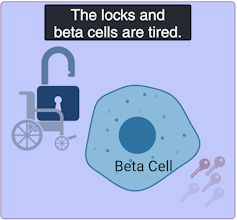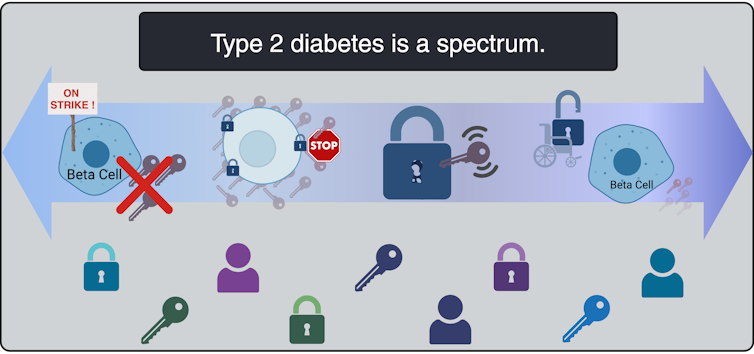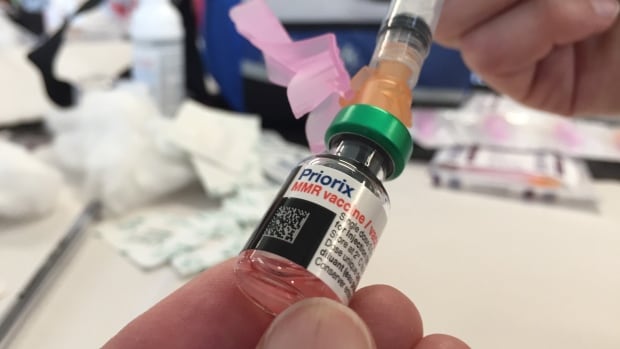Health
An outbreak of the deadly Marburg virus has been confirmed. Here’s what you need to know

|
|
The World Health Organization this week confirmed an outbreak of the Marburg virus in Equatorial Guinea — the first time the tiny country in Central Africa has seen cases of the deadly illness.
Marburg, which is related to Ebola, is already being blamed for at least nine deaths in the country, and another 16 suspected cases are being investigated.
Without treatment, Marburg can be fatal in up to 88 per cent of people.
A 2004-05 outbreak in Angola killed 90 per cent of the 252 confirmed cases.
Here is what you need to know about this rare but dangerous virus.
What is Marburg virus?
Marburg virus is believed to have originated in African fruit bats. It was first identified in 1967 in Germany and the former Yugoslavia, according to the U.S. Centers for Disease Control and Prevention, among people who had been working with green monkeys that had been imported from Uganda.
According to the World Health Organization (WHO), people can contract the virus through prolonged exposure in mines or caves where the bat colonies live.
The virus spreads between humans through direct contact with blood or other bodily fluids of an infected individual, or with surfaces contaminated with the virus, such as clothing or bed sheets.
Marburg is not airborne.
What are the symptoms?
Symptoms may begin “abruptly,” according to WHO, and include high fever, severe headache and malaise. Muscle aches and pains are also common.
“It can impact every organ, and it essentially will cause a shock-like syndrome,” said Dr. Isaac Bogoch, an infectious diseases specialist at Toronto General Hospital.
He said the virus can also cause gastrointestinal complications and a predilection to easy bleeding.
WHO says a rash can appear in the first seven days, and the central nervous system can be affected, resulting in confusion, aggression and irritability.
If death occurs, it generally happens eight to nine days after onset, following severe blood loss and shock.
How is it treated?
There is currently no vaccine for Marburg and no therapeutics to treat it. But patients can be helped.
“They need supportive care,” Bogoch said, including intravenous fluids, as well as electrolyte balance and monitoring. “That can significantly lower the mortality rate,” he said.
Where are the confirmed cases now?
Cases connected to the current outbreak in Equatorial Guinea were first detected in the northern province of Kie-Ntem, near the border with Cameroon.
The outbreak was confirmed after samples were sent to a lab in Senegal. Suspected cases from Cameroon and Gabon were also investigated but found not to be Marburg, WHO said.
But that doesn’t mean there aren’t more Marburg cases.
“When new diseases appear in new locations, we are often just seeing a piece of the picture,” said Dr. Kamran Khan, the founder and CEO of Toronto-based BlueDot, a company that tracks infectious diseases around the world.
He said there are probably more cases and more contacts than the official numbers would indicate, noting that Equatorial Guinea is one of the most resource limited countries in the world.
“Its capabilities in terms of its health-care system, its public health infrastructure for countering an outbreak, are pretty limited,” he said.
WHO said it is sending medical experts to help local officials in Equatorial Guinea, along with protective equipment for hundreds of workers.
“Surveillance in the field has been intensified,” said George Ameh, WHO’s country representative in Equatorial Guinea.
“Contact tracing, as you know, is a cornerstone of the response. We have … redeployed the COVID-19 teams that were there for contact tracing and quickly retrofitted them to really help us out.”
WHO director general Tedros Adhanom Ghebreyesus said the agency is also supporting the governments of Cameroon and Gabon “to prepare, to rapidly detect, isolate and provide care for any suspected cases.”
WHO director general Tedros Adhanom Ghebreyesus says the agency is sending teams and supplies to the Central African country of Equatorial Guinea to try to contain the current outbreak of the deadly Marburg virus.
Is there a concern about spread?
The current Marburg outbreak appears to be regional, but Bogoch notes that infection on one part of the Earth can quickly land on another part in a very short time frame.
“We saw that with, for example, the West African Ebola virus epidemic — which started off as a very small outbreak, turned into a multi-country, multi-year outbreak that took a long time to get under control.”
Khan of BlueDot said Equatorial Guinea is going to need international assistance to be able to get ahead of this outbreak. “Today, it’s a concern for the region and some of the neighbouring countries. But if we don’t get ahead of this, this could become a broader concern for the global community.”
Should people living in Canada be worried?
There’s probably no immediate concern about a case of Marburg being found in Canada.
“I think this is important for Canadians to understand that the likelihood of a case of Marburg showing up in Canada right now is exceedingly low,” Kahn said. But he said it’s important to be aware of the larger issue — which is that “there are more outbreaks appearing in the world today, they are becoming larger, they are becoming more dangerous and disruptive.”
Bogoch said while the current Marburg outbreak is small, now is the time to jump on it so that it doesn’t expand.
Canadians should always care when people anywhere, even far away, are being affected by a deadly illness, he said. “But we should also care about it because, of course, we know that it can impact areas far beyond that as well.”





Health
Cancer Awareness Month – Métis Nation of Alberta


Cancer Awareness Month
Posted on: Apr 18, 2024
April is Cancer Awareness Month
As we recognize Cancer Awareness Month, we stand together to raise awareness, support those affected, advocate for prevention, early detection, and continued research towards a cure. Cancer is the leading cause of death for Métis women and the second leading cause of death for Métis men. The Otipemisiwak Métis Government of the Métis Nation Within Alberta is working hard to ensure that available supports for Métis Citizens battling cancer are culturally appropriate, comprehensive, and accessible by Métis Albertans at all stages of their cancer journey.
Receiving a cancer diagnosis, whether for yourself or a loved one, can feel overwhelming, leaving you unsure of where to turn for support. In June, our government will be launching the Cancer Supports and Navigation Program which will further support Métis Albertans and their families experiencing cancer by connecting them to OMG-specific cancer resources, external resources, and providing navigation support through the health care system. This program will also include Métis-specific peer support groups for those affected by cancer.
With funding from the Canadian Partnership Against Cancer (CPAC) we have also developed the Métis Cancer Care Course to ensure that Métis Albertans have access to culturally safe and appropriate cancer services. This course is available to cancer care professionals across the country and provides an overview of who Métis people are, our culture, our approaches to health and wellbeing, our experiences with cancer care, and our cancer journey.
Together, we can make a difference in the fight against cancer and ensure equitable access to culturally safe and appropriate care for all Métis Albertans. Please click on the links below to learn more about the supports available for Métis Albertans, including our Compassionate Care: Cancer Transportation program.
I wish you all good health and happiness!
Bobbi Paul-Alook
Secretary of Health & Seniors
Health
Type 2 diabetes is not one-size-fits-all: Subtypes affect complications and treatment options – The Conversation


You may have heard of Ozempic, the “miracle drug” for weight loss, but did you know that it was actually designed as a new treatment to manage diabetes? In Canada, diabetes affects approximately 10 per cent of the general population. Of those cases, 90 per cent have Type 2 diabetes.
This metabolic disorder is characterized by persistent high blood sugar levels, which can be accompanied by secondary health challenges, including a higher risk of stroke and kidney disease.
Locks and keys
In Type 2 diabetes, the body struggles to maintain blood sugar levels in an acceptable range. Every cell in the body needs sugar as an energy source, but too much sugar can be toxic to cells. This equilibrium needs to be tightly controlled and is regulated by a lock and key system.
In the body’s attempt to manage blood sugar levels and ensure that cells receive the right amount of energy, the pancreatic hormone, insulin, functions like a key. Cells cover themselves with locks that respond perfectly to insulin keys to facilitate the entry of sugar into cells.
Unfortunately, this lock and key system doesn’t always perform as expected. The body can encounter difficulties producing an adequate number of insulin keys, and/or the locks can become stubborn and unresponsive to insulin.
All forms of diabetes share the challenge of high blood sugar levels; however, diabetes is not a singular condition; it exists as a spectrum. Although diabetes is broadly categorized into two main types, Type 1 and Type 2, each presents a diversity of subtypes, especially Type 2 diabetes.
These subtypes carry their own characteristics and risks, and do not respond uniformly to the same treatments.
To better serve people living with Type 2 diabetes, and to move away from a “one size fits all” approach, it is beneficial to understand which subtype of Type 2 diabetes a person lives with. When someone needs a blood transfusion, the medical team needs to know the patient’s blood type. It should be the same for diabetes so a tailored and effective game plan can be implemented.
This article explores four unique subtypes of Type 2 diabetes, shedding light on their causes, complications and some of their specific treatment avenues.
Severe insulin-deficient diabetes: We’re missing keys!
(Lili Grieco-St-Pierre, Jennifer Bruin/Created with BioRender.com)
Insulin is produced by beta cells, which are found in the pancreas. In the severe insulin-deficient diabetes (SIDD) subtype, the key factories — the beta cells — are on strike. Ultimately, there are fewer keys in the body to unlock the cells and allow entry of sugar from the blood.
SIDD primarily affects younger, leaner individuals, and unfortunately, increases the risk of eye disease and blindness, among other complications. Why the beta cells go on strike remains largely unknown, but since there is an insulin deficiency, treatment often involves insulin injections.
Severe insulin-resistant diabetes: But it’s always locked!

(Lili Grieco-St-Pierre, Jennifer Bruin/Created with BioRender.com)
In the severe insulin-resistant diabetes (SIRD) subtype, the locks are overstimulated and start ignoring the keys. As a result, the beta cells produce even more keys to compensate. This can be measured as high levels of insulin in the blood, also known as hyperinsulinemia.
This resistance to insulin is particularly prominent in individuals with higher body weight. Patients with SIRD have an increased risk of complications such as fatty liver disease. There are many treatment avenues for these patients but no consensus about the optimal approach; patients often require high doses of insulin.
Mild obesity-related diabetes: The locks are sticky!

(Lili Grieco-St-Pierre, Jennifer Bruin/Created with BioRender.com)
Mild obesity-related (MOD) diabetes represents a nuanced aspect of Type 2 diabetes, often observed in individuals with higher body weight. Unlike more severe subtypes, MOD is characterized by a more measured response to insulin. The locks are “sticky,” so it is challenging for the key to click in place and open the lock. While MOD is connected to body weight, the comparatively less severe nature of MOD distinguishes it from other diabetes subtypes.
To minimize complications, treatment should include maintaining a healthy diet, managing body weight, and incorporating as much aerobic exercise as possible. This is where drugs like Ozempic can be prescribed to control the evolution of the disease, in part by managing body weight.
Mild age-related diabetes: I’m tired of controlling blood sugar!

(Lili Grieco-St-Pierre, Jennifer Bruin/Created with BioRender.com)
Mild age-related diabetes (MARD) happens more often in older people and typically starts later in life. With time, the key factory is not as productive, and the locks become stubborn. People with MARD find it tricky to manage their blood sugar, but it usually doesn’t lead to severe complications.
Among the different subtypes of diabetes, MARD is the most common.
Unique locks, varied keys
While efforts have been made to classify diabetes subtypes, new subtypes are still being identified, making proper clinical assessment and treatment plans challenging.
In Canada, unique cases of Type 2 diabetes were identified in Indigenous children from Northern Manitoba and Northwestern Ontario by Dr. Heather Dean and colleagues in the 1980s and 90s. Despite initial skepticism from the scientific community, which typically associated Type 2 diabetes with adults rather than children, clinical teams persisted in identifying this as a distinct subtype of Type 2 diabetes, called childhood-onset Type 2 diabetes.
Read more:
Indigenous community research partnerships can help address health inequities
Childhood-onset Type 2 diabetes is on the rise across Canada, but disproportionately affects Indigenous youth. It is undoubtedly linked to the intergenerational trauma associated with colonization in these communities. While many factors are likely involved, recent studies have discovered that exposure of a fetus to Type 2 diabetes during pregnancy increases the risk that the baby will develop diabetes later in life.
Acknowledging this distinct subtype of Type 2 diabetes in First Nations communities has led to the implementation of a community-based health action plan aimed at addressing the unique challenges faced by Indigenous Peoples. It is hoped that partnered research between communities and researchers will continue to help us understand childhood-onset Type 2 diabetes and how to effectively prevent and treat it.
A mosaic of conditions

(Lili Grieco-St-Pierre, Jennifer Bruin/Created with BioRender.com)
Type 2 diabetes is not uniform; it’s a mosaic of conditions, each with its own characteristics. Since diabetes presents so uniquely in every patient, even categorizing into subtypes does not guarantee how the disease will evolve. However, understanding these subtypes is a good starting point to help doctors create personalized plans for people living with the condition.
While Indigenous communities, lower-income households and individuals living with obesity already face a higher risk of developing Type 2 diabetes than the general population, tailored solutions may offer hope for better management. This emphasizes the urgent need for more precise assessments of diabetes subtypes to help customize therapeutic strategies and management strategies. This will improve care for all patients, including those from vulnerable and understudied populations.
Health
Quebec successfully pushes back against rise in measles cases – CBC.ca


Quebec appears to be winning its battle against the rising tide of measles after 45 cases were confirmed province-wide this year.
“We’ve had no locally transmitted measles cases since March 25, so that’s good news,” said Dr. Paul Le Guerrier, responsible for immunization for Montreal Public Health.
There are 17 patients with measles in Quebec currently, and the most recent case is somebody who was infected while abroad, he said.
But it was no small task to get to this point.
Le Guerrier said once local transmission was detected, news was spread fast among health centres to ensure proper protocols were followed — such as not letting potentially infected people sit in waiting rooms for hours on end.
Then about 90 staffers were put to work, tracking down those who were in contact with positive cases and are not properly vaccinated. They were given post-exposure prophylaxis, which prevents disease, said Le Guerrier.
From there, a vaccination campaign was launched, especially in daycares, schools and neighbourhoods with low inoculation rates. There was an effort to convince parents to get their children vaccinated.
Vaccination in schools boosted
Some schools, mostly in Montreal, had vaccination rates as low as 30 or 40 per cent.
“Vaccination was well accepted and parents responded well,” said Le Guerrier. “Some schools went from very low to as high as 85 to 90 per cent vaccination coverage.”
But it’s not only children who aren’t properly vaccinated. Le Guerrier said people need two doses after age one to be fully inoculated, and he encouraged people to check their status.
There are all kinds of reasons why people aren’t vaccinated, but it’s only about five per cent who are against immunization, he said. So far, some 10,000 people have been vaccinated against measles province-wide during this campaign, Le Guerrier said.
The next step is to continue pushing for further vaccination, but he said, small outbreaks are likely in the future as measles is spreading abroad and travellers are likely to bring it back with them.
Need to improve vaccination rate, expert says
Dr. Donald Vinh, an infectious diseases specialist from the McGill University Health Centre, said it’s not time to rest on our laurels, but this is a good indication that public health is able to take action quickly and that people are willing to listen to health recommendations.
“We are not seeing new cases or at least the new cases are not exceeding the number of cases that we can handle,” said Vinh.
“So these are all reassuring signs, but I don’t think it’s a sign that we need to become complacent.”
Vinh said there are also signs that the public is lagging in vaccine coverage and it’s important to respond to this with improved education and access. Otherwise, microbes capitalize on our weaknesses, he said.
Getting vaccination coverage up to an adequate level is necessary, Vinh said, or more small outbreaks like this will continue to happen.
“And it’s very possible that we may not be able to get one under control if we don’t react quickly enough,” he said.
-



 Science11 hours ago
Science11 hours agoJeremy Hansen – The Canadian Encyclopedia
-



 Tech10 hours ago
Tech10 hours agoSave $700 Off This 4K Projector at Amazon While You Still Can – CNET
-



 Investment11 hours ago
Investment11 hours agoUK Mulls New Curbs on Outbound Investment Over Security Risks – BNN Bloomberg
-



 Tech9 hours ago
Tech9 hours ago'Kingdom Come: Deliverance II' Revealed In Epic New Trailer And It Looks Incredible – Forbes
-



 Sports9 hours ago
Sports9 hours agoAuston Matthews denied 70th goal as depleted Leafs lose last regular-season game – Toronto Sun
-
Business8 hours ago
BC short-term rental rules take effect May 1 – CityNews Vancouver
-
Real eState10 hours ago
Sick of Your Blue State? These Real Estate Agents Have Just the Place for You. – The New York Times
-



 Investment8 hours ago
Investment8 hours agoBenjamin Bergen: Why would anyone invest in Canada now? – National Post




